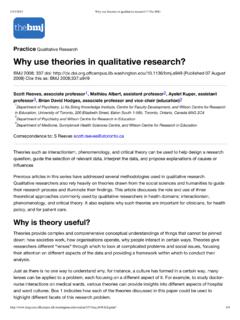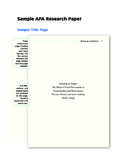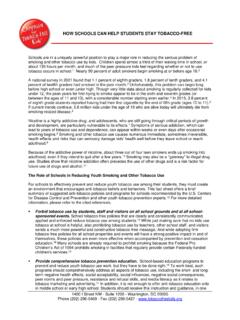Transcription of The Use of First Language in the Second-Language Classroom ...
1 50 The Use of First Language in the Second- Language Classroom : A Support for Second Language Acquisition1 El Uso de la Lengua Materna en el Sal n de la Clase de Ingl s: Un Apoyo para la Adquisici n de una Segunda LenguaMara Salmona Madri an2*Colegio Nueva Granada, ColombiaAbstractThis action research project was carried out in order to identify the role of First Language in the second- Language Classroom . This study was conducted in a Colombian international school with an English immersion program for kindergarten students attending their First year of school. The purpose of this study was to identify if the use of the mother tongue in the Classroom increases comprehension and facilitates the second Language acquisition process. Two lesson plans were designed: the First one using only English as the Language of instruction, and the second one using both languages, Spanish and English.
2 The results demonstrate that students do benefit from the use of the First Language in the Classroom , transferring concepts from their mother tongue to the new Language . Keywords: Second Language acquisition, Language transfer, First Language acquisition, Language of instructionResumenEsta investigaci n acci n fue desarrollada con el fin de identificar el rol de la primera lengua en el sal n de clase con un programa de inmersi n a la segunda lengua. Este estudio se llev a cabo en un colegio internacional colombiano 1 Received: July 15, 2014 / Accepted: October 6, 2014 2 Education and LEarninG research JournaL. issn 1692-5777. no. 9, (JuLy- dEcEmbEr) 2014. pp. 50-66. saLmona No. 9 (July - December 2014) No. 9 (July - December 2014)51caracterizado por su programa biling e de inmersi n al ingl s.
3 El objetivo de esta investigaci n era identificar si el uso de la lengua materna en el sal n de clase aumenta la comprensi n y facilita as el proceso de adquisici n de la segunda lengua. Para desarrollar esta investigaci n, se desarrollaron dos planeadores de clase: el primero usando ingl s nicamente durante la instrucci n y el desarrollo de la actividad, y el segundo alternando entre espa ol e ingl s durante la instrucci n y el desarrollo de la actividad. Los resultados demuestran que los estudiantes s se benefician del uso de la primera lengua puesto que pueden transferir conceptos de su lengua materna al nuevo idioma. Palabras clave: Adquisici n de una segunda lengua, transferencia ling stica, adquisici n de lengua materna, lengua de instrucci nResumoEsta pesquisa a o foi desenvolvida com a finalidade de identificar o papel da primeira l ngua na sala de aula, com um programa de imers o segunda l ngua.
4 Este estudo foi realizado em um col gio internacional colombiano, caracterizado pelo seu programa bil ngue de imers o ao ingl s. O objetivo desta pesquisa era identificar se o uso da l ngua materna na sala de aula aumenta a compreens o e facilita, assim, o processo de aquisi o da segunda l ngua. Para desenvolver esta pesquisa desenvolveram-se dois planejadores de aula: o primeiro, usando ingl s somente durante a instru o e o desenvolvimento da atividade; e o segundo, reversando entre espanhol e ingl s durante a instru o e o desenvolvimento da atividade. Os resultados demonstram que os estudantes sim, se beneficiam do uso da primeira l ngua, j que podem transferir conceitos da sua l ngua materna ao novo idioma. Palavras chave: Aquisi o de uma segunda l ngua, transfer ncia lingu stica, aquisi o de l ngua materna, l ngua de instru oIntroductionAs globalization and population movements are increasing, different cultures come into greater contact with each other, resulting in the need for communication between societies (Hamers & Blanc, 2000).
5 Thus, being bilingual has become a vital aspect for becoming a successful professional, making bilingualism the main component in education. In fact, a bilingual person has more opportunities to obtain a better job and to have more achievements than a monolingual person. Therefore, elementary schools, high schools, and universities have to face the need for bilingualism by educating students who are able to work in these multicultural societies. If students receive bilingual education from their First years of school, the level of proficiency in the second Language should increase. In fact, the more saLmona No. 9 (July - December 2014) No. 9 (July - December 2014)52students are exposed to a new Language , the easier they learn the target Language due to brain development (Piaget & Inhelder, 1969).
6 That is why today, teachers in bilingual schools and Language teachers are challenged to teach children to help them reach the level of proficiency required for learning demanding academic content and ensuring complete cognitive development. Cognitive development is understood in this study as the construction of thought processes, including problem-solving, decision-making, reasoning, and Language development (Piaget & Inhelder, 1969).This research was conducted at a private international school in Bogot . This large urban institution is an example of a bilingual school with an English immersion program where students are exposed to English from their First year of school. From kindergarten to 12th grade, students receive all classes in English, except Spanish and extracurricular activities.
7 During the First years in immersion schools, students face academic content in a Language they have never been exposed to before, making the learning process a challenge. In fact, if children use a Language which is not well developed during writing, speaking, reading or listening activities, the cognitive system will not function at its best (Cummins, 2000). According to the curriculum for kindergarten at this school, the number of hours in English (second Language ) and Spanish ( First Language ) are not equivalent. As students are learning a second Language , most of the classes are in English. Even though the school has changed the curriculum during the past two years, due to the importance of developing the mother tongue from the First year at school, the amount of hours in Spanish and English are not the same.
8 In fact, kindergarten students (the First year of school) only receive three hours of Spanish per week and the rest of their classes in English. The subjects in this study were kindergarten students between four and six years old. They were all Colombians and most of them received a little exposure to English at their nursery school in order to prepare them for elementary school. Moreover, it is mandatory that at least one of the parents speaks English in order to apply to this school. However, students only know a few words in English, as for example to count up to five or to name the colors. During the First year of school, students are supposed to learn the alphabet, both in English and Spanish. The common underlying proficiency model proposed by Cummins suggests that the languages in a bilingual or multilingual person do not work independently; they work through the same processing system (Cummins, 2000).
9 In fact, a student who knows how to multiply in thE usE of First Language saLmona No. 9 (July - December 2014) No. 9 (July - December 2014)53 Spanish does not need to be taught how to do it in English because the processing system is the same. However, if the student does not have a well-developed Language of instruction, he will not perform effectively, and therefore due to the lack of understanding, cognitive development will not be as good as it could be. Furthermore, as we are talking about kindergarten students starting their literacy process, it is important to take into account the stages of Language development. In fact, during the First stages of Language acquisition it is important to constantly refer to the mother tongue in order to make connections (Cummins, 2001). Previous knowledge in kindergarten students is a starting point for acquiring a new Language , leading to Language transfer (Baker, 2001).
10 Language transfer is understood as the use of the First Language during the second Language acquisition, which represents the First stage of Language acquisition (Krashen, 2003). Moreover, during the First year of school it is vital that the First Language is developed in students. In fact, First Language development is required in order to have good strategies to transfer to the new Language . If students do not have good strategies in their mother tongue, they will not have good strategies to transfer to the new Language , and therefore the cognitive development will be reduced (Friedlander, 1997). Due to the importance of First Language development, the school in this study has now increased the number of Spanish hours in kindergarten. In the second Language acquisition process, it may be useful for teachers to teach the new Language using the mother tongue as support in order to develop not only the target Language but also the cognitive development required to be academically and professionally successful.












